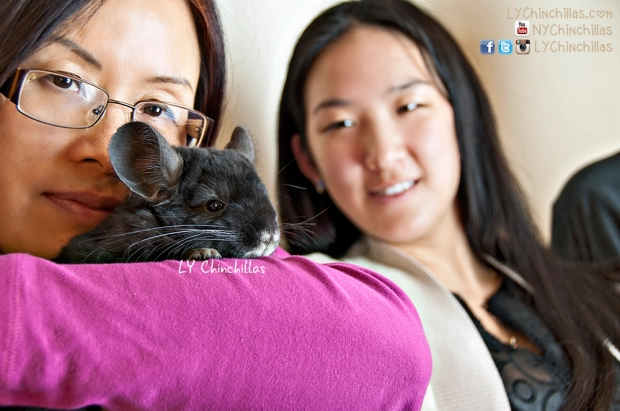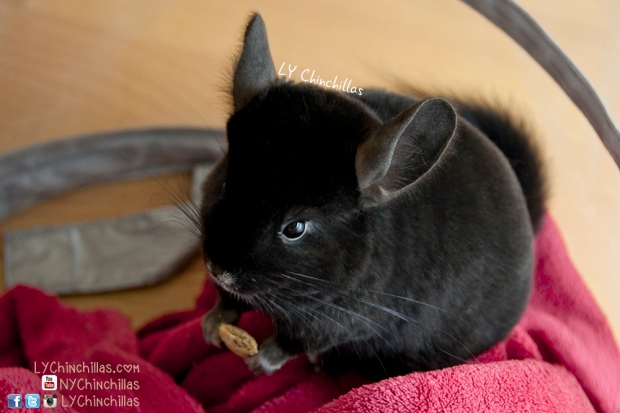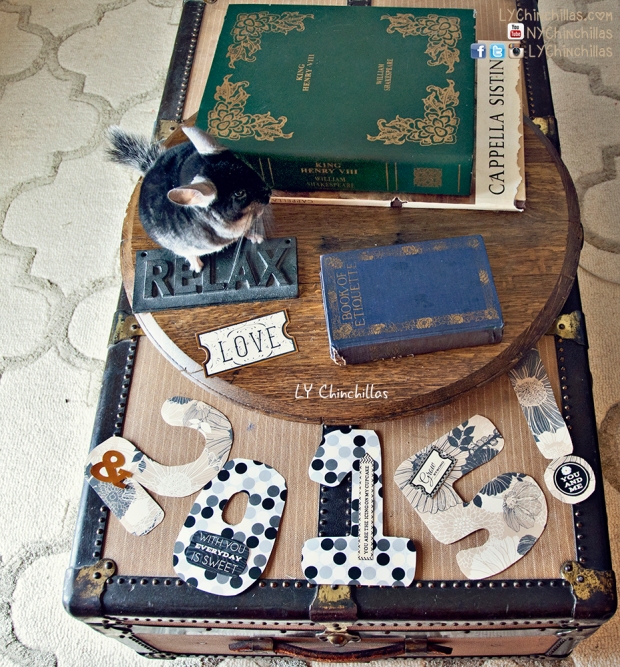Here we are traipsing the threshold of 2015, and it’s golden skies and sunny days as far as the eye can see (optimism, optimism!). Instead of writing a post on this year’s reflection (which, if you do want to read, I’ve already written), I’m going to instead share something that could be useful to you and your sweet furry pets in the new year – especially for all you new chinchilla owners. Today’s post will be all about best bonding practices!
There are a few major pointers I’d like to make to cast an umbrella over the whole of this post, which I think are good fundamental rules to follow in the entirety of your relationship with your pet:
- Set realistic expectations. Try very, very hard not to idealize your relationship with your chinchilla. A lot of chinchilla owners become disheartened when they learn their adorable new pet doesn’t seem to reciprocate their feelings. Be ready to be disliked or apathetically treated for months! The need for instant gratification is something we have become accustomed to in our society, but it shouldn’t be automatically transferred to human or animal relationships. The crux of good relationships take time, energy, and more time.
- Chinchillas are people, too. What I mean by this is, chins have exuberant and specific personalities and great memories. They resemble people in their ability to feel emotion, have thoughts, and hold opinions, although they are not able to express it in ways that appear clairvoyant to humans. Chins are all different, with different mannerisms, idiosyncrasies, and intelligence levels. So to say, not all chins should be treated the same way and it’s necessary to try your best to come to an understanding about who your chinchilla is.
- Above all, take your time and stay positive. Anyone who has successfully bonded with their chinchillas will be able to tell you that it’s one of the most rewarding processes and relationships they’ve been able to build. You won’t get there if you give up! It’s brick-by-brick; Rome wasn’t built in a day; take it slow and keep a steady pace with your bonding techniques, and you’ll get there eventually!

Step 1: Introductions! When you first meet your darling chinchilla(s), there will be a great deal of confusion on their end. They’ve likely been through the ringer on the first day in their new home, what with transport, new smells, sounds, and vibrations. Hopefully, their last owner provided you with some of their pellets so you can make an eventual transition to their new feed over the course of several weeks. If not, they’ll have the added stress of a new diet to deal with. It’s important to be understanding during the first few weeks. They will be understandably skittish and scared – but don’t worry, chinchillas are extremely adaptable, resilient, and curious, and will come to know their cage and environment within a day or two. Some owners have found that having a television on by the cage has helped alleviate stress during a move and acted as a distraction for their chinchillas during times of change. In this initial introductory period, you should spend time around your chinchilla, but should not force them to leave their cage or be unwillingly held if not needed. It’s always helpful to speak quietly to your chinchilla in a calming voice, allowing them to become familiarized to your baseline temperament. Once your chinchilla begins to feel safe and the introductory period is nearing an end, you’ll notice your chinchilla approaching you with curiosity and willingness. In some cases, this can happen almost immediately with a very social and friendly chin – in most cases, the process takes much longer, up to several months. In the meantime, it’s time for Step 2.

Step 2: Develop a Routine! Adopt a healthy diet, dusting routine, and cleaning schedule for your chinchillas. Feeding your chins should be a daily exercise. Free feeding pellets is the way to go; hays and pellets should be re-upped every day to ensure maximal freshness. When you’re in the cage, be sure to say hi to your chinchilla and remind them what a great job you’re doing as a parent. As far as dusting goes, since my chinchillas don’t have dry skin issues and all love to dust, I have a dust compartment separate from their cages that I allow them access to every day. Since it’s a controlled dusting environment and not a free-for-all, I use their dusting time as an opportunity to pick them up, hold them briefly, and weigh them daily. I’ve found that this daily routine has helped me bond with my chin-kids, learning how they like to be picked up, how long they can tolerate a cuddle, and reassuring them that I’m still here for them. Additionally, it’s helpful to objectively weigh their growth – based on water and food consumption and time of day, chinchillas can gain or lose up to 20 grams per day, but as long as the overall trajectory is weight gain and not loss, there isn’t much to worry about. All chin owners know that cleaning is needed almost daily. Deep cleaning occurs perhaps once or twice a week, but some minor tidying is a daily task. During this time, I like to sing to my chins, even though human bystanders insist they’re begging me to stop (I know the truth: that they LOVE it). The importance of routine cannot be overlooked – it’s the daily interactions that amount to aggregate care. Nobody said caring for a chinchilla was easy, and if they did, they were wrong! It does gets easier though, once you adopt a manageable schedule and supportive network.

Step 3: Playtime! Given your chinchilla is over 6 months old, you can let them out for playtime once or twice a week. Eventually, as long as you have the time and energy to supervise a safe playtime session and know your chinchilla well enough, even daily playtime is fine. I’d suggest starting out in a bathroom or closet for 10 minutes at a time, sitting with them and allowing them to learn and explore the space before moving on to a larger area. To read more about playtime tips, read this post. Not every chinchilla is fond of playtime, some prefer their cage. However, playtime is always a great way to boost trust and confidence in one another, getting to know your little friend through exploration. The more attention and interaction you give your chinchilla, the better their quality of life and the more satisfied they’ll be in their home. Boredom can be a killer for any species, especially for intelligent, active, caged chinchillas. Stimulation is critical for their health and happiness – physical activity can help ebb the issue of containment or inactivity. Hopefully, in addition to a great playtime, your chinchillas have access to a large, spacious, and fun cage where they can explore, chew, and entertain themselves during your off hours. If not, you can look into building your own cage for them! It’s a lot of work, but a lot of reward as well.
Step 4: Lots of Love! There are a plethora of ways to continue on the bonding process. Offering scratches to your chinchillas behind the ears and under the chin can be a great way to bond! For chinnies that don’t want to be scratched, chew toys are always a great peace offering. Teaching your chins that you feed them, bathe them, and treat them helps to develop a great maternal or paternal relationship with your chin-kid. Essentially, any amount of quality time spent with your chinchilla serves to improve human-chinchilla relations, bringing you and your chin closer each day. It’s the little successes that often make us happiest, since these little critters can’t speak or sing or shout about how much they love us. There’s really nothing that can replace the time and energy spent towards great care. We can only do the very best that we can do. Your chinchillas will come to respect you and appreciate you, and simply take you for granted. But, isn’t that just the joy of it all anyhow? You see, that’s the ultimate takeaway from all the hard work that goes into bonding with your chinchilla. You’ve just come to the end of this lengthy article on bonding, but the truth is, if you are a great pet owner, you’ll do everything you can for the animals you love, expecting absolutely nothing in return. Just safety, health, and happiness! That’s our motto – Happy 2015 ya’ll!

Don’t forget to keep in touch with us – YouTube, Facebook, Instagram andTwitter! Follow us into the New Year! 🙂

LY Chinchillas Treat Donation
Donate healthy, delicious treats to LY Chinchillas to help keep our content going!
$5.00
Hi, we are relatively new to owning chinchillas {Very new} Our 2 are about 6 month old males and as far as bonding as concerned, for the first couple of weeks we talked to them and then we introduced play time in the bathroom. We now have a pen round their cage so that play tome they can explore a good area but have access to their cage or safe place whenever they want. We sit in with them and talk to them and they will climb on us . We have managed to stroke them briefly at times but not very much.
Now to get to handle them and move things on do we continue as we are and gradually they may become more friendly naturally or do we just pick them up and they will get use to it that way. My concerns that if we try the latter method then we may lose the trust that we have gained already. I would be most grateful for your advice
John
LikeLike
Hi John! Thanks for reaching out. I suggest to utilize your cleaning time or dust time to pick them up once a day so they get used to it. They do need to recognize that you are in control of their playtimes and dusting sessions, and consistency is understood to them. Other than that, it’s really just time and building up trust (from weeks to months or even longer) for them. Since they are so independent and have such specific personalities, it completely will depend on the personality of your chinchilla. I have a few who LOVE scratches and two who don’t. But, one thing to note is that most chinchillas are NOT ‘cuddling’ chinchillas. By their nature, chinchillas are prey animals and that instinct is generally quite strong. However, they will come to show their care in their own ways so don’t be discouraged if there are some growing pains.
LikeLike
Hi! So I moved in with my boyfriend and his chilla Benjamin about 8 months ago. Bonding was going slow but good for a couple of months, I could pick him up and give him scratches. However, something happened (don’t know what) and now he acts like he hates me. He chases and bites me really hard during play time if I move around the house. I have been feeding him every morning and trying to be patient but it is starting to get very discouraging. Do you have any advice on how to bond with him better without him taking my fingers off?
LikeLike